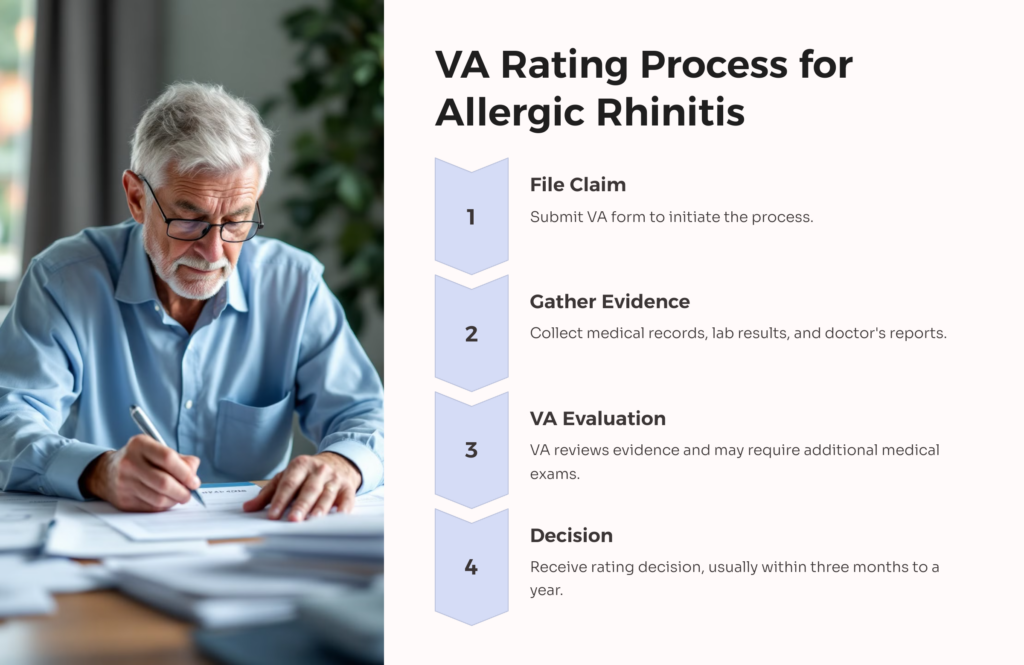Allergic Rhinitis is a severe allergic reaction that is typified by symptoms like a runny nose, sneezing, itchy eyes, nasal congestion, and sinus pressure. Many veterans deal with allergic rhinitis, and like all disabilities faced by veterans, it is assessed by Veteran Affairs to determine whether the veteran can receive compensation. A VA disability rating, assigned by the U.S. Department of Veteran Affairs (VA), help establish the severity of a veteran’s disability and thus, determine the amount of VA disability compensation they receive. Why are these VA ratings deemed significant? They not only aid in determining the compensation amount but also provide an understanding of the physical or mental limitations of the veterans due to their service-related medical condition.
Overview of Allergic Rhinitis

Developing an overview of allergic rhinitis gives us insight into its historical context, rhinitis symptoms, and the overall impact it has on daily living. Its history dates back to 1873 when Charles Blackley first identified pollen as an allergen and a major cause of seasonal allergies – what we now call allergic rhinitis.
Allergic rhinitis symptoms include a mild allergic reaction, recurrent sneezing, itchy, watery eyes, nasal congestion, increased mucus production, and sometimes, sinus infections. This condition can significantly impair a person’s quality of life, disturbing their sleeping patterns, reducing concentration, and restricting daily activities due to fatigue.
The VA & Disability Evaluations

Veteran Affairs plays a vital part in veterans’ healthcare by providing healthcare services, veteran benefits programs, and access to national cemeteries. Disability benefits offered by the VA are paramount to ensuring veterans receive the aid they require for injuries or illnesses with a service connection.
A VA disability rating can range from 0% to 100%, in increments of 10. Considering factors such as the nature and severity of the medical condition, its effect on normal function, and the resultant impact on the veteran’s ability to work, VA ratings provide a baseline for the amount of benefits available. More severe disabilities receive higher ratings and thus larger compensation amounts.
Understanding Allergic Rhinitis VA Rating
In evaluating an allergic rhinitis VA claim, specific rating criteria set by the VA and the VA diagnostic code are followed. This is usually based on the frequency, duration, and severity of the episodes.
Respiratory health conditions, like allergic rhinitis, chronic sinusitis, or sleep apnea are all evaluated and can receive a wide range of VA ratings depending on the severity of the symptoms and the degree of service connection. A respiratory condition that is a result of burn pit exposure will likely score a higher rating as it has a strong service connection.
The disability levels, denoted by percentages, depict the severity of the condition and its impact on the individual’s life. A 10% rating may mean the individual experiences mild symptoms with little impact on their daily life, while a higher rating, like 50%, could indicate severe, frequent episodes that severely disrupt daily life activities.
The VA Rating Process for Allergic Rhinitis

The VA application process for a disability rating begins with filing a disability claim by submitting a VA form, followed by gathering all related medical evidence. Required documentation includes a complete medical record, treatments, lab results, doctor’s reports, and sometimes, the results of VA medical exams.
While the timeline for receiving a decision can vary greatly, most veterans receive a decision within three months to a year. Potential challenges can include delays in processing, lack of adequate medical record or documentation, or disagreements on assigned ratings.
Seeking Help in Securing a VA Rating for Allergic Rhinitis

For many veterans, the entire VA claim and rating process may appear daunting. Thus, getting help is not just important; it’s almost necessary. A range of professionals are available to assist with the process, including VA-accredited attorneys and claims agents.
When seeking professional assistance, some key factors to consider include their experience with VA claims, their working style, their fee structure, and their commitment to helping veterans. It’s also important to note that VA laws prohibit charging veterans for representation before a claim decision is made.
In conclusion, understanding allergic rhinitis and the VA Ratings associated with it is crucial for veterans. It sheds light on the extent of their condition and its impact on daily life, and aids in making informed decisions about claiming their VA benefits.
We encourage veterans suffering from allergic rhinitis or other similar respiratory health issues like chronic sinusitis or obstructive sleep apnea, especially as a result of burn pit exposure, to learn more about their VA benefits and to seek guidance in navigating this process, to ensure they receive appropriate compensation for their service-related conditions.
 AllVeteran.com Advisors
AllVeteran.com Advisors
With expertise spanning local, state, and federal benefit programs, our team is dedicated to guiding individuals towards the perfect program tailored to their unique circumstances.











